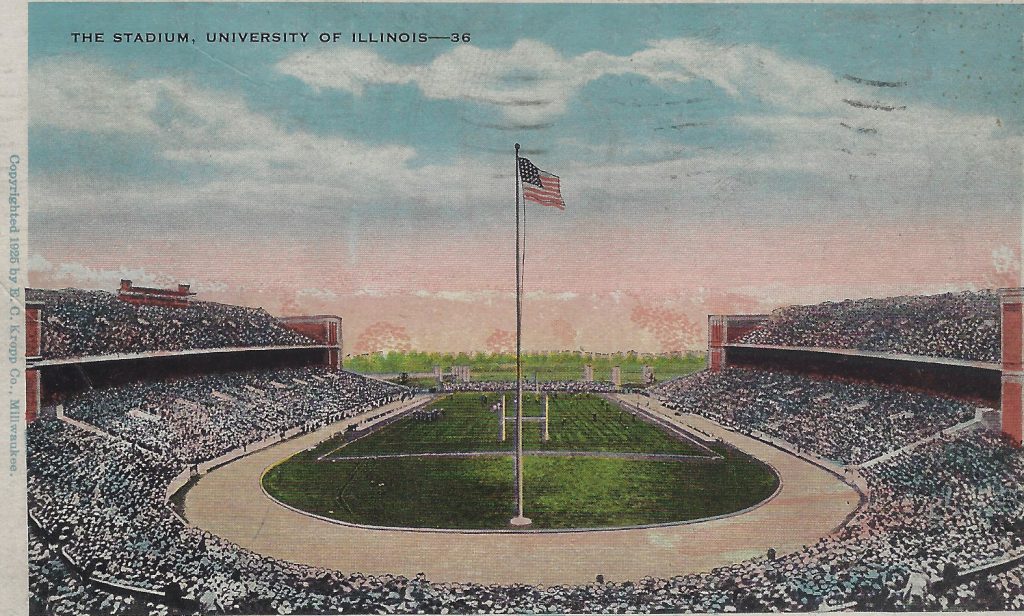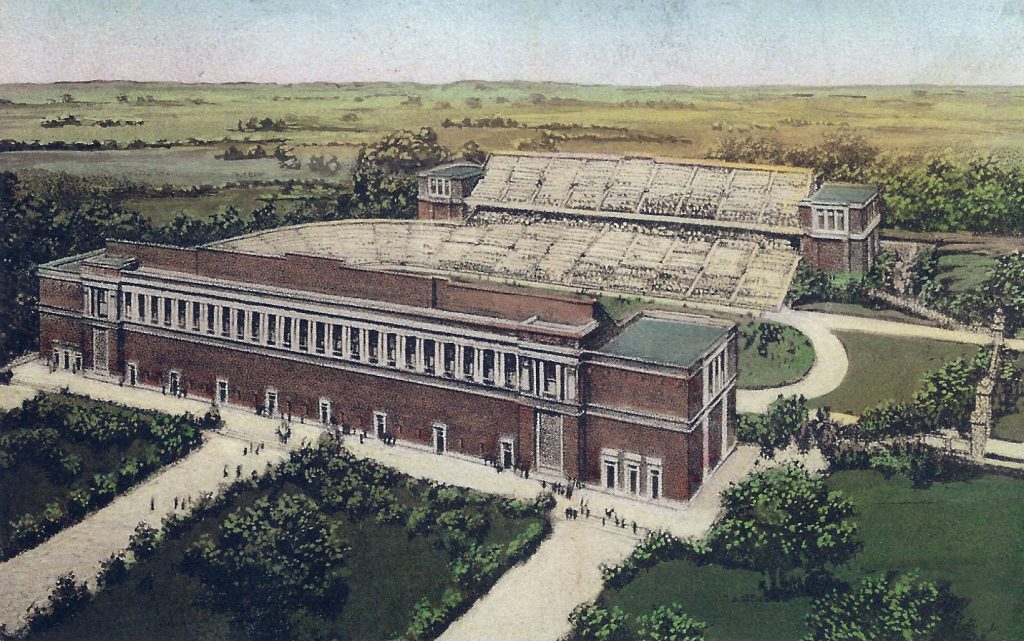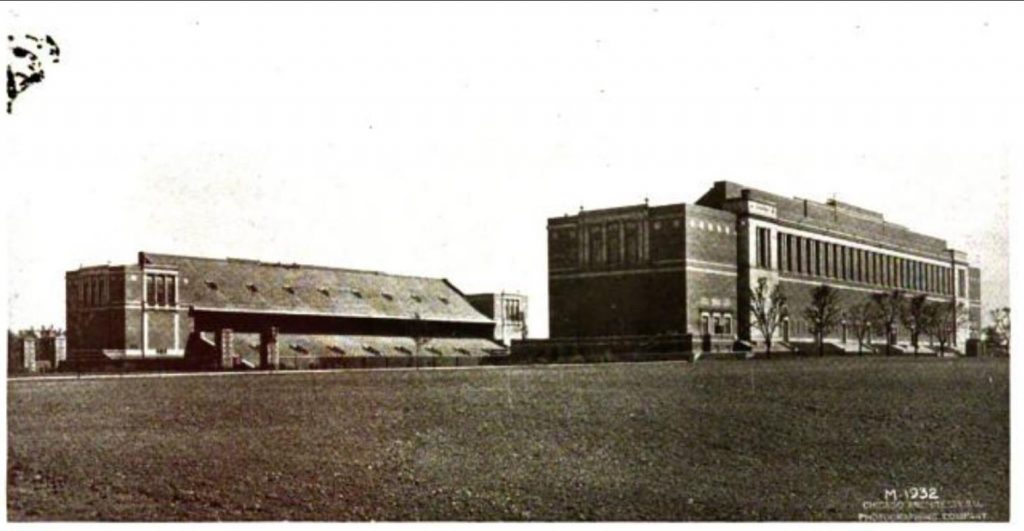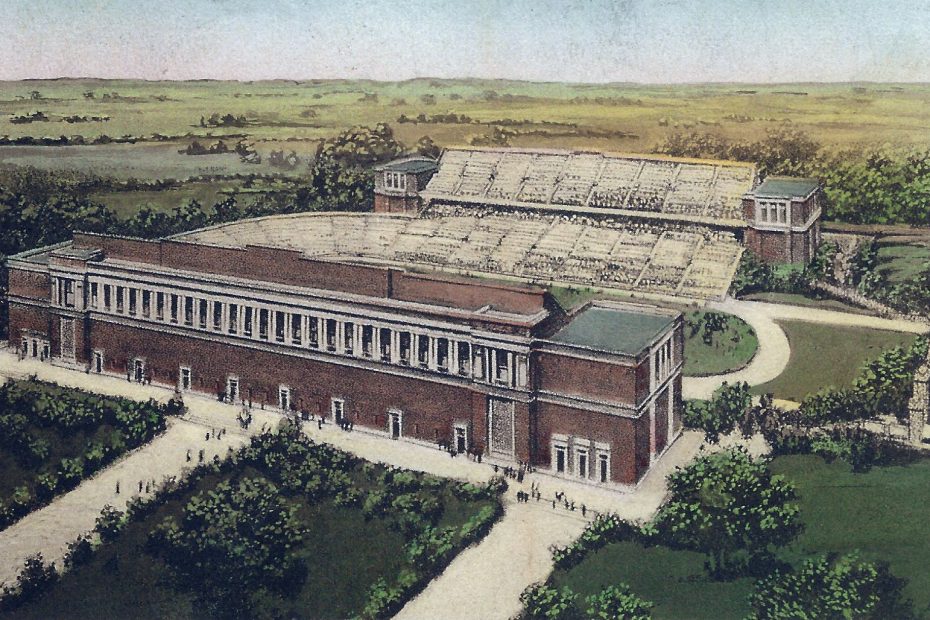Constructed 1922-1923, Dedicated 1924, Horseshoe Addition 1929, West Stand Press Box, Hospitality Suites, and North End Zone Addition, 2006-07
Celebrating 100 Years of Illinois Memorial Stadium
In 2023, the University of Illinois celebrates the 100th anniversary of its Memorial Stadium. Undeniably, the football home of Fighting Illini is steeped in college sports and recreational history. Located at the south end of the Champaign-Urbana campus, Illinois Memorial Stadium remains a striking, functional, and sensitively updated architectural landmark.
The noted Chicago architectural firm of Holabird and Roche designed Illinois Memorial Stadium in 1922-23. This brick and reinforced concrete architectural design richly represents the emergence of a new type of structure in the early 20th-century: the large-scale American sports stadium.
The University of Illinois constructed its first football stadium in what is known as the Golden Era of College Football. While most U.S. universities built campus stadiums in closed oval or horseshoe (U-shaped) plans in the first two decades of the 20th-century, Illinois Memorial Stadium built one of the first rectangular plan stadiums with two decks of fan seating, on opposite sides. Athletic administrators chose a rectangular plan specifically to allow for numerous close spectator views for football games, then the University’s principal revenue generating sport. The stadium’s stately colonnade marked it as a World War I Memorial, as well as a character defining architectural feature. After the University announced stadium plans in 1922, architectural and engineering periodicals featured Memorial Stadium’s double-deck, steel-frame and concrete structure.

Tell Me More, Tell Me More, It was Love at First Sight for the National Park Service
In the 1980s, National Park Service (NPS) historians identified Illinois Memorial Stadium as one of America’s most architecturally and historically significant college stadiums. Memorial Stadium is one of just nine stadiums and “bowls” recognized in a groundbreaking 1986 Recreation in the United States Theme Study of potential National Historic Landmarks in the United States.[i] This first look study identified a broad range of individual properties that are important in the history of recreation in the U.S. The study identified “outstanding and illustrative examples” with a major impact on American recreational history in the following categories: (1) baseball parks; (2) stadiums and bowls; (3) college athletic facilities; (4) cricket, tennis, and lawn bowling; (5) racetracks and speedways; (6) public parks and gardens; (7) world’s fair and exposition sites; (B) amusement parks, carousels, and roller coasters; (9) circus sites; (10) zoos; (11) nautical recreation and sports; (12) resort hotels, spas, casinos, and camps; (13) science as recreation; and (14) pageantry and festivals.[ii] The most casual sports fan or traveler will recognize many of the properties listed in the study.
Landmark Football Stadiums and Bowls
One easily recognized stadium, Los Angeles Memorial Coliseum, received National Historic Landmark (NHL) designation in 1984. As a result of the NPS study, Harvard Stadium, Yale Bowl, The Rose Bowl, and Grant Park Stadium (Soldier Field) all received NHL designations. (The National Park Service delisted Soldier Field in Chicago in 2006 following callous renovation of the Classical Revival structure.) In 1987, the National Park Service did not recommend NHL designation for University of Michigan Stadium, likely due to insensitive renovations and enlargements over time. Finally, for reasons unknown, University of Notre Dame Stadium, Ohio Stadium, and University of Illinois Memorial Stadium did not receive National Historic Landmarks designation shortly after the study. Ohio Stadium received individual designation on the National Register of Historic Places in 1974. Notre Dame Stadium was excluded from the University of Notre Dame Main and South Quadrangles National Register Historic District in 1978.
Other Landmark Football Stadiums
While not part of the NPS Study, other college football stadiums may be landmark worthy for their architectural or historical significance. These stadiums may be listed individually on the National Register of Historic Places or as part of National Register historic districts. For example, California Memorial Stadium in Berkeley, CA received listing on the National Register of Historic Places in 2006. Others may be locally designated landmarks. Currently, Illinois Memorial Stadium is not designated a local landmark, nor is it included individually or as part of a historic district in the National Register of Historic Places, nor is it a National Historic Landmark (NHL). At the same time, however, University of Illinois has two National Historic Landmarks on campus: the Morrow Plots and the Astronomical Observatory.

Architectural and Engineering Periodicals Cover College Football Stadiums of the Golden Era
A review of architectural and engineering periodicals of the early to mid 20th-century reveals which college football stadiums may be valued for their architectural significance. Periodicals such as American Architect, Architectural Record, Engineering Record, Engineering News, Western Society of Engineering Journal, Engineer and Contractor, Electric World, Popular Mechanics, Concrete, and Scientific American all published articles on new American football stadiums. In October 1923, The American Architect reported widespread interest and building activity involving college football stadiums. In turn, they published a series of articles describing several new stadiums with construction details, as well as older stadium structures.
Architecture and engineering periodicals included notable early 20th-century college football stadiums:
- Harvard Stadium, Boston, MA (built 1903)
- Archbold Stadium, Syracuse University, Syracuse, NY (built 1905-07, demolished 1979)
- Stagg Field, University of Chicago, Chicago, IL (1913, 1925, now demolished)
- Frederick H. Cossitt Hall South Bowl, Colorado College, Colorado Springs, CO (built 1913-14, bowl demolished 1957)
- Palmer Memorial Stadium, Princeton University, Princeton, NJ (built 1914, demolished 1996)
- Yale Bowl, Yale University, New Haven, CT (1914)
- City Stadium (Balboa Stadium), San Diego, CA (built 1914, demolished 1970s)
- Lewisohn Stadium, College of the City of New York, New York City, NY, (built 1915, demolished 1973)
- Schoellkopf Field (Cornell Crescent), Cornell University, Ithaca, NY (1915, 1924)
- Husky Stadium, University of Washington, Seattle, WA (built 1920)
- Ohio Stadium, The Ohio State University, Columbus, OH (built 1921-22)
- Rose Bowl, Pasadena, CA (built 1921, south end 1929)
- Stanford Stadium, Stanford University, Stanford, CA (built 1921, demolished 2005)
- Soldier Field, Chicago, IL (built 1922-26, renovated 2003)
- Kansas Memorial Stadium (now David Booth Kansas Memorial Stadium), University of Kansas, Lawrence, KS (built 1921)
- Illinois Memorial Stadium, University of Illinois, Champaign, IL (1922-24)
- Terre Haute Memorial Stadium, Terre Haute, IN, (1922-25, mostly demolished 1968-69)
- California Memorial Stadium, University of California, Berkeley, CA (1922-23)
- Inman Field, University of South Dakota, Vermillion, SD (1923, 1925, demolished by 1979)
- Memorial Field Stadium, Dartmouth College, Hanover, NH (1923)
- Iowa Stadium (Kinnick Stadium), University of Iowa, Iowa City, IA (built 1923, 1928-29)
- Nebraska Memorial Stadium, University of Nebraska, Lincoln, NE (1923)
- Franklin Field Stadium, University of Pennsylvania (built 1895, additions and alterations 1922, 1925)
- Texas Memorial Stadium, University of Texas, Austin, TX (1924)
- Colorado Stadium (Folsom Field), University of Colorado, Boulder, CO (1924)
- Denver University Stadium (Hilltop Stadium), Denver, CO (1925-26, demolished 1971)
- Brown University Field, Providence, RI (opened 1925)
- Missouri Memorial Stadium (Faurot Field), University of Missouri, Columbia, MO (1925-1927)
- Dyche Stadium (Ryan Field), Northwestern University, Evanston, IL (1926, 1949 south end zone enclosure)
- Sesquicentennial Stadium (Philadelphia Municipal Stadium), Philadelphia, PA (1926, demolished 1992)
- Multnomah Stadium, Civic Stadium, Portland, OR (1926)
- South Dakota University Stadium, University of South Dakota, Vermillion, SD (1926)
- Michigan Stadium, University of Michigan, Ann Arbor, MI (1926-27)
- Chelsea Memorial Stadium, Chelsea, MA (1934-35, demolished ca. 2019
Illinois State Historic Preservation Office Evaluated Illinois Memorial Stadium for Landmark Eligibility
Besides inclusion in architectural periodicals of the day, more recent experts identified Illinois Memorial Stadium for its significance in architecture, engineering and recreational history. As part of the stadium’s renovation plans in 2006, a historic preservation analysis conducted with review from the State Historic Preservation Office (SHPO), determined Illinois Memorial Stadium is eligible for both listing in the National Register of Historic Places (NRHP) and designation as a National Historic Landmark (NHL). The University of Illinois’ own Facilities and Services Department, under the Campus Historic Preservation Officer, evaluated Illinois Memorial Stadium for its architectural and historical significance. Its 4.21 preservation index score places the stadium in the top 20 important historic buildings on the University of Illinois campus.
America’s First Double-Decked Rectangular Football Stadium

The University of Illinois enjoys a rare, intact historic sports facility. Tasteful updates meet the needs of today’s student-athletes, university administrators and staff, fans, and media. As tastes and economies in sports and amusement change, many historic properties associated with America’s recreational history have been lost. Some historic properties lose architectural integrity from insensitive renovation. Other recreational properties no longer retain their original use or purpose and are left to decay. Finally, some historic recreational sites retain their original use, but are demolished anyway.
While other elite universities honor their football stadiums with individual historic landmark designation, as of this centennial year, the University has not initiated any landmark designation for Illinois Memorial Stadium. Perhaps during this pivotal year, university administration will honor this architecturally outstanding, nationally-significant structure in American recreational history. National Historic Landmark designation is a start.
“Obviously, without its physical plant a university could not exist, but buildings reflect many things other than pure utility. A campus is a diary of the times reflecting the vigor of the University, the economic and social climate of the country, and the changing tastes and ideas of each era.”
Charles S. Havens, University of Illinois Director of Physical Plant Planning and Construction, 1968
[i] Charleton, James H. Recreation in the United States: National Historic Landmark Theme Study. Washington, D.C.: United States Department of the Interior, National Park Service, 1986, p. 3.
[ii] Ibid, pp. 3-4.
MORE TO COME…research and writing in progress
Copyright © Jennifer Kenny, 2023. No part of this site, www.localarchitecturechicago.com, may be reproduced in whole or in part in any manner without the permission of the copyright owner
